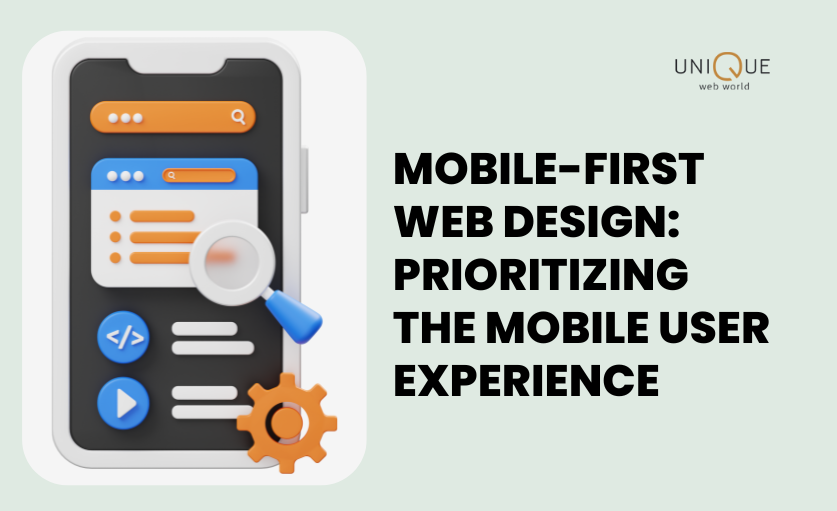A key strategy for businesses and developers seeking to optimise their online presence in the quickly expanding digital ecosystem is the shift towards mobile first web design. Designing with mobile devices in mind before expanding to larger screens is not only the sensible thing to do, but also the necessary one, given that most people access the internet through their cellphones. By putting the mobile user experience first, this method guarantees that websites are accessible, interesting, and completely functional even on tiny devices. Designing with mobile devices in mind allows developers and designers to make responsive layouts that work equally well on large desktop screens as they do on the tiniest smartphones.
The Very Core of Mobile-First Design
Mobile first web design is a philosophy that involves starting the design process with the mobile version of a site, which is then adapted for larger screens. This strategy is rooted in the understanding that mobile users have different needs and limitations, such as smaller screen size and variable internet speeds. Focusing on these constraints from the outset encourages simplicity, speed, and clarity in design.
Why Mobile-First Matters to Search Engines
Search engines, led by giants like Google, have increasingly prioritized mobile-friendly websites in their ranking algorithms. A mobile-first approach not only aligns with these preferences but also enhances site visibility and performance in search results. By catering to the mobile user experience first, websites can significantly improve their SEO standing, driving more organic traffic and engagement.
Design Approaches for Small Screens
Designing for small screens involves several key considerations, including optimizing visual hierarchy, minimizing load time, and ensuring that all elements are easily navigable on a touchscreen. Responsive web design plays a crucial role, employing fluid grids and flexible images to ensure content looks great and functions well, regardless of screen size.
Adapting Design for Tablet and Desktop
While the mobile-first approach begins with small screens, it doesn’t neglect the importance of tablet and desktop users. Responsive designs gracefully scale up to accommodate larger screens, with adjustments made to layout, white space, and interactive elements to enhance the desktop user experience. This ensures that all users, regardless of device, enjoy optimal interaction with the website.
The Role of White Space in Mobile Design
White space, or the use of empty space around and between elements, is a critical design tool that improves readability and focus, especially on small screens. In mobile-first design, white space is strategically used to create a clean, uncluttered interface that enhances user engagement and makes key information stand out.
Implementing a Mobile-First Design Strategy
Implementing a mobile-first design strategy involves a shift in the traditional design process. Designers and developers must prioritize content and functionality that are essential for mobile users, stripping away any superfluous elements that could hinder performance or distract from the user’s primary goals. This streamlined approach ensures faster load times and a more focused user experience.
Responsive vs. Adaptive Design
While responsive web design is often associated with the mobile-first approach, it’s important to distinguish it from adaptive design. Responsive designs fluidly change to fit any screen size, while adaptive designs have fixed layout sizes that ‘snap’ into place when the screen reaches certain breakpoints. Both approaches can be part of a mobile-first strategy, but responsive design offers greater flexibility and efficiency in creating multi-device compatible websites.
The Importance of Load Time
Load time is a critical factor in the success of mobile websites. Users expect fast, efficient access to information, regardless of their device or network speed. Optimizing images, minimizing code, and leveraging browser caching are all strategies that can improve load time, significantly enhancing the mobile user experience.
Collaboration Between Designers and Developers
A successful mobile-first web design requires close collaboration between designers and developers. This partnership ensures that design visions are technically feasible and that developers can influence the design process with insights into what is possible within the constraints of current web technologies. This collaborative approach leads to more innovative and effective design solutions.
Finally
Mobile-first web design is not just a trend; it’s a fundamental shift in how we approach website creation in an increasingly mobile-centric world. By starting the design process with the needs of mobile users in mind, businesses can create more accessible, engaging, and effective websites. This strategic focus ensures that websites are primed for the future, ready to meet the demands of users and search engines alike. As mobile internet usage continues to grow, adopting a mobile-first approach will become even more essential for companies looking to stay competitive in the digital marketplace.


Recent Comments